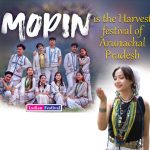Is the Harvest Festival of Arunachal Pradesh
Festivals are an essential part of socio-cultural life of every community and an expressive way to celebrate culture, heritage and tradition. It brings people together and reduces differences. It is believed that the festivals are a mirror
of the culture of any state. Arunachal Pradesh in northeast India is known as the ‘Land of the Rising Sun’ or ‘The Land of Dawnlit Mountains’ has, since earlier times, a rich cultural heritage. The culture of the state is varied as it has
many tribes, sub-tribes who have different belief systems. Therefore, different festivals are observed in every corner of Arunachal Pradesh.
Every society celebrates number of festivals annually. These could relate to agriculture, religion and socio-cultural. The God-fearing people of the state celebrate numerous festivals round the year, each with their own set of rituals,
music and dance. Among all the festivals of Arunachal Pradesh, Mopin is the most colourful agricultural festival. The festival is well-known, has carnivals and is celebrated by the Galo community and Adi tribes. The Galo tribe is mainly
found in the Siang Frontier Division of the state. (East Siang and West Siang districts). It is a sub-group of the Adis. The Adi people are one of the most popular groups in the state. Their festivals dazzle you. Their main festival Mopin
is celebrated in the month of April. Deeper intent behind celebration is to be blessed with prosperity and wealth. You get to see traditional dances too. Popir, generally performed by girls, with a lead singer and Erap (a traditional dance)
is the main dance of the Galo. Mopin festival is a celebration of the harvesting season which is held in the Galo months of “Lumi” and “Luki”, corresponding to March-April every year.
Officially, the date of celebration is April 5. In villages, it starts a month prior. It is celebrated by the people to bring wealth, good health and prosperity for the whole community. Such festivals are celebrated to thank Gods for their
providence and praying for a good crop. An important reason behind celebrating this festival is to drive away evil spirits who bring bad luck and create obstacles.
A local drink called Apung or Poka (a special type of wine, prepared by fermentation of rice) is generally distributed among the participants in a bamboo cup. Like in the festival of Holi revellers’ apply Ette or rice flour on face of
others. Smearing rice powder on each other faces marks the beginning of the festival. It is considered a holy ritual. Note rice is the main staple food of the Galo people. Animal sacrifice is one of the rituals of the Mopin festival. The
act of animal sacrifice is an essential local tradition. Men and women crowd around to witness it. Mithun (a bovine species found only in North East India and Burma) is regarded a very auspicious animal for sacrifice.
Galo people believe it will bring a successful harvest and a prosperous new year. For them, the blood of the sacrificed Mithun is believe to bring good luck. Galo women consider it as a blessing so collect drops of blood, take it home and
to villages. Participant perform a local traditional dance called Popir at this event. During this festival, the locals pray so that the shadow of any devastating natural calamity does not hit them and they can lead their lives peacefully
and prosperously. They believe that this festival brings good luck to the whole community, purifies their souls and keeps away diseases and misfortune. Another feature of the Mopin festival is a dance known as Popir. It is one of the most
popular folk dance forms of Arunachal Pradesh. It is an indigenous dance form performed by young girls and women in a very elegant way. This beautiful dance form shows great resemblance with the Ponung Dance (one of the most important folk
dance of Arunachal Pradesh performed by women dancers before harvesting crops). This dance is mainly performed by young girls, and the performers wear white dress and elaborate headgears. They dance in their best traditional costumes and
adorn themselves with multi-coloured beaded ornaments which look graceful and elegant. Tribes also sing various traditional songs and rhymes and the folks follow the dance steps accordingly. By positioning themselves in a circular queue
they create a roaring sound with their rhythmic steps.
Among the group, one group chant the sweet words of Ja-Jin-Ja (a folk song of Arunachal Pradesh sung during marriages and other social occasions that celebrates the history and ancestors of the people) and Baryi (a narrative song on the
history that takes hours to complete) folk songs, while the other group complements their song with dancing.
They also organize various cultural activities. During this festival, rice wine or apong and variety of meals are served. All prepared by Galo women of the community. They also prepare vegetarian and non-vegetarian mouthwatering dishes and
recipes for them. The festival of Mopin of Galo tribes also has a socio-cultural belief and its story carries many meaningful messages for the good health of all human beings.
Behind the celebration, each festival has some innate values, indispensable for the development of morality among the people living in that society. A society has culture, faith and activities as is destined by the creator Donyi Polo (a
designation given to the indigenous religion in the Tibeto- Burma tradition, where Donyi depicts Father Sun and Polo means Mother Moon), God, Bhagawan or the Supreme Power.
Mopin festival is organized in the beginning of the agriculture cycle, but actually Mopin is a worship of Goddess named Mopin Ane.
Mopin Ane, the Goddess is as important to the Galos as Goddess Lakshmi is to many Indians. Adi tribe worship Mopin Ane as she brings in prosperity, health and wealth in villages. The festival of Mopin provides various agricultural
implements and seeds and also teaches the art of cultivation to Abo-Tani (tribe is considered the progenitor of the Tani tribes of Arunachal). The Goddess of Mopin Ane is mostly revered by people, with extra zeal and enthusiasm in the
harvest season of April. The importance of Mother Mopin can be compared with Lakshmi and Annapurna Devi. The celebration can be equated with the celebration of the Minoans (an inhabitant of Minoan Crete or Minoan civilization during the
early Dark ages). Several different deities were worshipped like the God of animal and hunt.
Bulls were also believed to be sacred. The most important deity is a goddess of the earth and fertility. The Adi people worship Mother Mopin as the “Creator of fertility” every year. The Mopin is famous as Goddess of Animal, Birds and
Insects (Fauna) and the festival of Mopin also tells the people of the community how to stop slaughtering and selling their meat.Mopin is also all about care for the environment and preservation of vegetation. In this festival, the most
important part is throwing and flecking rice grains on each other faces which is a symbol of purity, social harmony, exchange of love and affection and showering of plenty fullness. During this festival, a large numbers of devotees gather
in a crowded place to celebrate their most colourful and vintage crop carnival.

















Add Comment